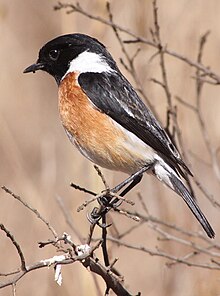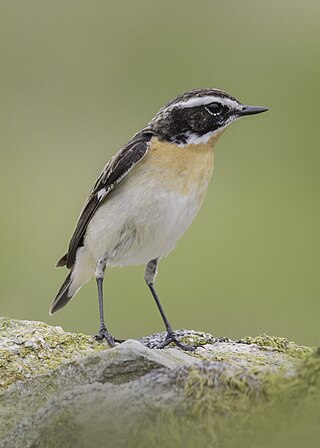
The whinchat is a small migratory passerine bird breeding in Europe and western Asia and wintering in central Africa. At one time considered to be in the thrush family, Turdidae, it is now placed in the Old World flycatcher family, Muscicapidae. Both sexes have a strong supercilium, brownish upper parts mottled darker, a pale throat and breast, a pale buff to whitish belly, and a blackish tail with white bases to the outer tail feathers, but in the breeding season, the male has an orange-buff throat and breast.
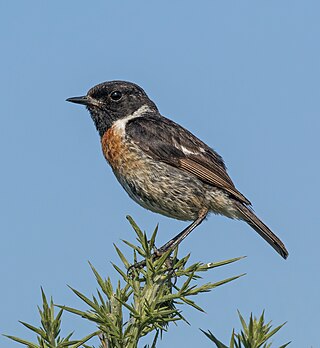
The European stonechat is a small passerine bird that was formerly classed as a subspecies of the common stonechat. Long considered a member of the thrush family, Turdidae, genetic evidence has placed it and its relatives in the Old World flycatcher family, Muscicapidae. It is found across Europe, as far east as Ukraine and the South Caucasus, and in parts of North Africa.

The Canary Islands stonechat, also known as the Fuerteventura stonechat or Fuerteventura chat, and formerly known as the Canary Islands chat due to its once widespread distribution on the Canary Islands, is a sedentary resident bird found only on the island of Fuerteventura where it is known as the Caldereta.

The Siberian stonechat or Asian stonechat is a recently validated species of the Old World flycatcher family (Muscicapidae). Like the other thrush-like flycatchers, it was often placed in the Turdidae in the past. It breeds in the East Palearctic including in easternmost Europe and winters in the Old World tropics.

The pied bush chat is a small passerine bird found ranging from West Asia and Central Asia to the Indian subcontinent and Southeast Asia. About sixteen subspecies are recognized through its wide range with many island forms. It is a familiar bird of countryside and open scrub or grassland where it is found perched at the top of short thorn trees or other shrubs, looking out for insect prey. They pick up insects mainly from the ground, and were, like other chats, placed in the thrush family Turdidae, but are now considered as Old World flycatchers.

Common stonechat is the name used for the Saxicola species Saxicola torquatus when this is treated in its broad sense.

Saxicola, the stonechats or chats, is a genus of 15 species of small passerine birds restricted to the Old World. They are insectivores occurring in open scrubland and grassland with scattered small shrubs.

The Cape longclaw or orange-throated longclaw is a passerine bird in the family Motacillidae, which comprises the longclaws, pipits and wagtails. It occurs in Southern Africa in Zimbabwe and southern and eastern South Africa. This species is found in coastal and mountain grassland, often near water.

The collared aracari or collared araçari is a near-passerine bird in the toucan family Ramphastidae. It is found from Mexico to Colombia and Venezuela.

The collared puffbird is a species of bird in the family Bucconidae, the puffbirds, nunlets, and nunbirds. It is found in Bolivia, Brazil, Colombia, Ecuador, French Guiana, Guyana, Peru, Suriname, and Venezuela.

The white-browed bush chat, also known as Stoliczka's bushchat, is an Old World flycatcher in the genus Saxicola. The alternative name is after the discoverer, geologist and explorer Ferdinand Stoliczka.
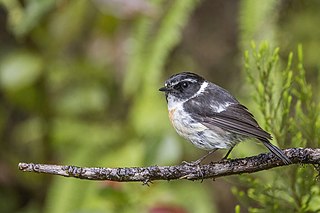
The Réunion stonechat is a species of stonechat, endemic to the island of Réunion. This small passerine bird is common in clearings and open mountain bushlands there up to 2600 metres above sea level, including in the plains around Piton de la Fournaise.
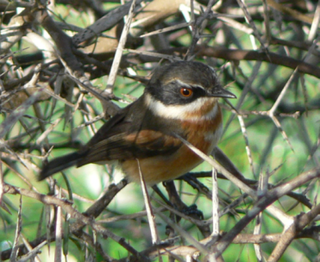
The Cape batis is a small, stout insect-eating passerine bird in the wattle-eye family. It is endemic to the Afromontane forests of southern Africa.

The scissor-tailed nightjar is a species of nightjar in the family Caprimulgidae. It is distributed over much of eastern South America.

The wing-banded antbird is a species of passerine bird in subfamily Myrmornithinae of family Thamnophilidae, the "typical antbirds". It is found in Brazil, Colombia, Ecuador, French Guiana, Guyana, Nicaragua, Panama, Peru, Suriname, and Venezuela.

The ringed woodpecker is a species of bird in subfamily Picinae of the woodpecker family Picidae. It is found in every mainland South American country except Argentina, Chile, Paraguay, and Uruguay.
Torquatus, masculine, is a Latin word meaning "adorned with a neck chain or collar" and may refer to:

The Amur stonechat or Stejneger's stonechat is a species of stonechat native to eastern Asia. It breeds in central and eastern Siberia, Japan, Korea, northeastern China, and eastern Mongolia, and migrates south to southern China and Indochina in winter.

The Madagascar stonechat is a species of stonechat, endemic to Madagascar. It is a small bird, closely similar to the African stonechat in both plumage and behaviour, but distinguished from it by the more extensive black on the throat and minimal orange-red on the upper breast of the males.

The coconut lorikeet, also known as the green-naped lorikeet, is a parrot in the family Psittaculidae. Seven species of lorikeets now recognised were once lumped together under Trichoglossus haematodus.
